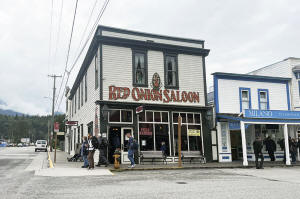From Alaska to Maine, communities that border Canada worry US tariffs
come at a personal cost
[March 03, 2025] By
DEE-ANN DURBIN and SALLY HO
DETROIT (AP) — At the U.S. Embassy in Ottawa, a quote from former
President Ronald Reagan is engraved on one wall.
“Let the 5,000-mile border between Canada and the United States stand as
a symbol for the future," Reagan said upon signing a 1988 free trade
pact with America’s northern neighbor. "Let it forever be not a point of
division but a meeting place between our great and true friends.”
But a point of division is here. On Tuesday, President Donald Trump
plans to impose a 25% tariff on most imported Canadian goods and a 10%
tariff on Canadian oil and gas. Mexico is also facing a 25% tariff.
Canada has said it will retaliate with a 25% import tax on a multitude
of American products, including wine, cigarettes and shotguns.
The tariffs have touched off a range of emotions along the world’s
longest international border, where residents and industries are closely
intertwined. Ranchers in Canada rely on American companies for farm
equipment, and export cattle and hogs to U.S. meat processors. U.S.
consumers enjoy thousands of gallons of Canadian maple syrup each year.
Canadian dogs and cats dine on U.S.-made pet food.
The trade dispute will have far-reaching spillover effects, from price
increases and paperwork backlogs to longer wait times at the U.S.-Canada
border for both people and products, said Laurie Trautman, director of
the Border Policy Research Institute at Western Washington University.
“These industries on both sides are built up out of a cross-border
relationship, and disruptions will play out on both sides,” Trautman
said.

Even the threat of tariffs may have already caused irreparable harm, she
said. Canadian Prime Minister Justin Trudeau has urged Canadians to buy
Canadian products and vacation at home.
The Associated Press wanted to know what residents and businesses were
thinking along the border that Reagan vowed would remain unburdened by
an “invisible barrier of economic suspicion and fear.” Here’s what they
said:
Skagway, Alaska-Whitehorse, Yukon
People flocked from the boomtown of Skagway, Alaska, to Canada’s Yukon
in search of riches during the Klondike gold rush of the late 1890s,
following routes that Indigenous tribes long used for trade.
Today, Skagway trades on its past, drawing more than 1 million cruise
ship passengers a year to a historic downtown that features
Klondike-themed museums. But the municipality with a population of about
1,100 still holds deep ties to the Yukon.
Skagway residents frequently travel to Whitehorse, the territory's
capital, for a wider selection of groceries and shopping, dental care,
veterinary services and swimming lessons. The Alaskan city's port,
meanwhile, still supports Yukon mining and is a critical hub for fuel
and other essentials both communities need.
“It’s a special connection,” Orion Hanson, a contractor and Skagway
Assembly member, said of Whitehorse, which sits 110 miles (177
kilometers) north and has 30,000 people. “It’s really our most
accessible neighbor.”
Hanson is concerned about what tariffs might mean for the price of
building supplies, such as lumber, concrete and steel. The cost of
living in small, remote places already is high. People in Whitehorse and
Skagway worry about the potential impact on community relations as well
as prices.
Norman Holler, who lives in Whitehorse, said the months the tariffs have
loomed created “an uncomfortable feeling and resentment.” If the threat
becomes reality, Holler said he would probably still visit Alaska border
towns but not other parts of the United States.
““Is it rational? I don’t know, but it satisfies an emotional need not
to go,” he said.
- Becky Bohrer in Juneau, Alaska
Point Roberts, Washington-Delta, British Columbia
At the border of Washington state and British Columbia, the tension over
tariffs is evident in a waterfront community that is hoping for Canadian
mercy.
Point Roberts is a 5-square-mile (13-square kilometer) U.S. exclave
whose only land connection lies in Canada, which supplies the
unincorporated nub of American soil its water and electricity. It’s a
geographic oddity that requires a 20-mile drive around Canada to reach
mainland Washington state.

Local real estate agent Wayne Lyle, who like many of his neighbors has
dual U.S.-Canadian citizenship, said some of Point Roberts’ roughly
1,000 residents are signing a petition pleading with British Columbia's
premier for an exemption to whatever retaliatory tariffs Canada may
institute.
“We’re basically connected to Canada. We’re about as Canadian as an
American city can be,” Lyle said. “We’re unique enough that maybe we can
get a break.”
Lyle, who serves as the president of the Point Roberts Chamber of
Commerce, said it’s too early to identify measurable effects, but he
fears Canadians won’t visit the popular summer getaway destination out
of spite.
“We don’t want Canada to think we’re the bad guys,” Lyle said. “Please
don’t take it out on us.”
- Sally Ho in Seattle
Billings, Montana-Alberta
The 545-mile (877-kilometer) stretch of land that separates Montana from
Canada includes some of the sleepiest checkpoints on the binational
border. Several of the state's border posts had fewer than 50 crossings
a day on average last year.
But unseen, in underground pipelines that cut through vast fields of
barley, flows about $5 billion annually worth of Canadian crude oil and
natural gas, most of it from Alberta. The lines traverse a continental
pivot point -- Montana is the only state with rivers that drain into the
Pacific Ocean, Gulf of Mexico and Canada’s Hudson Bay – and deliver to
refineries around Billings.
“Canada is one of our major supply sources for oil across the United
States,” said Dallas Scholes, the government affairs director of
Houston-based refinery company Par Pacific, which runs a processing
facility along the Yellowstone River. “If tariffs are imposed on the oil
and gas industry, … it’s not going to be good for consumers.”
People in Montana drive long distances given its sprawling size and burn
lots of natural gas through harsh winters, making its residents the
highest energy consumers per capita in the U.S., according to federal
data.

[to top of second column] |

Visitors walk in the downtown area of Skagway, Alaska, Wednesday,
July 31, 2024. (AP Photo/Mark Thiessen, File)
 That means a 10% tax on Canadian
energy resources would be felt broadly. The state’s farmers would be
among those hit more severely, given the large volumes of gasoline
needed to run tractors and other equipment, according to Jeffrey
Michael, director of the University of Montana’s Bureau of Business
and Economic Research.
“It will be painful, but there are larger concerns if I were an
agricultural producer in Montana,” Michael said. “I’d be worried
about the trade war escalating to where my products start to get hit
with reciprocal tariffs."
- Matthew Brown in Billings, Mont.
Detroit-Windsor, Ontario
The Detroit River is all that separates Windsor, Ontario, from
Detroit. The cities are so close that Detroiters can smell the
drying grain at Windsor’s Hiram Walker distillery and Windsor can
hear the music drifting from Detroit’s outdoor concert venues.
Manufacturing muscle makes the Ambassador Bridge, the 1.4-mile-long
span connecting the two cities, the busiest international crossing
in North America. According to the Michigan company that owns the
bridge, $323 million worth of goods travel each day between Windsor
and Detroit, the automotive capitals of their countries.
The U.S., Canada and Mexico have long operated as one nation when it
comes to auto manufacturing, noted Pat D’Eramo, CEO of Vaughan,
Ontario-based automotive suppler Martinrea. Tariffs will cause
confusion and disruption, he said.
Right now, steel coils arrive at a plant in Michigan and get stamped
into parts that are shipped to Martinrea in Canada. Martinrea uses
the parts to build vehicle sub-assemblies that get shipped back to
an automaker in Detroit.
A White House official told The Associated Press that parts would be
taxed twice if they crossed the border multiple times, but it's
unclear if suppliers or their customers will have to pay for the
tariffs. Also unclear is how a separate 25% levy on steel and
aluminum that Trump said would take effect starting March 12 factors
into the mix.
D’Eramo understands the impulse to strengthen U.S. manufacturing but
says the U.S. doesn’t have the capacity to make all the tooling
Martinrea would need if it were to shift production there. At the
end of the day, he thinks it’s sad tariffs will take up so much
time, energy and resources, and only make vehicles even more
expensive.
“We need to be spending our time and money to get more efficient and
reduce our costs so customers can reduce their costs,” he said.
-Dee-Ann Durbin in Detroit

Buffalo, New York-Ontario
Buffalo, New York is, decidedly, a beer town. It’s also a border
town.
That makes for a complementary relationship. Western New York’s
dozens of craft breweries rely on Canada for aluminum cans and much
of the malted grain that goes into their brews. Canadians regularly
cross one of the four international bridges into the region to shop,
go to sporting events and sip Buffalo's beers.
Brewers and other businesses fear there may be less of that, though,
if the tariffs on Canada and aluminum go into effect. Trump's
repeated comments about making the neighboring nation the 51st U.S.
state already offended its citizens - so much so that Buffalo’s
tourism agency paused a campaign running in Canada because of
negative comments.
“Obviously, having a bad taste in their mouth and booing the
national anthem at sporting events is not a great thing for them
coming down here and drinking our beer and hanging out in our city,”
said Jeff Ware, president of Resurgence Brewing Co.
The historic factory building housing Ware’s business in Buffalo is
about 4 miles from the Peace Bridge border crossing, where 1.8
million cars and buses and 518,000 commercial trucks entered Buffalo
from Ontario last year.
It’s a terrible time to alienate customers, Canadian or American.
The snowy first months of the year are hard enough for Buffalo’s
breweries, Ware said. Higher prices from 25% tariffs would be yet
another obstacle. Ware gets about 80% of the base malt be uses to
make his specialty beers from Canada.
“Labor is more expensive, energy is more expensive, all of our raw
ingredients are more expensive,” he said. “It’s death by a thousand
cuts.”
- Carolyn Thompson in Buffalo, N.Y.
Cutler, Maine-New Brunswick
Commercial lobsterman John Drouin has fished for Maine’s signature
seafood for more than 45 years, often in disputed waters known as
the “grey zone” that straddle the U.S.-Canada border.
The relationship between American and Canadian fishermen can
sometimes be fraught, but harvesters on both side of the border know
they depend on each other, Drouin said. Maine fishermen catch
millions of pounds of lobsters every year, but much of the
processing capacity for the valuable crustaceans is in Canada.
If Trump follows through with the threatened tariffs next week,
lobsters sent to Canada for processing would be subject to customs
duties when they return to the U.S. to go to market. Drouin fears
what will happen to the lobster industry if the trade dispute
persists and Canada enacts a retaliatory tariff on lobsters.

“As the price goes up to the consumer, there comes a point where it
just doesn’t become palatable for them to purchase it,” Drouin said.
Drouin, 60, fishes out of Cutler, Maine, and sees Grand Manan
Island, an island in the Bay of Fundy that is part of the province
of New Brunswick, when he takes his boat out. He described his
business as “right smack on the Canadian border” in terms of both
economics and geography.
He described himself as a fan of Trump’s first term who is “not
overly thrilled with what he’s been doing here.” And he said he’s
concerned his home state could ultimately be hurt by the tariffs if
the president isn’t mindful of border industries such as his.
“The rhetoric is a bit much, what’s taking place,” Drouin said.
- Patrick Whittle in Scarborough, Maine
All contents © copyright 2025 Associated Press. All rights reserved |